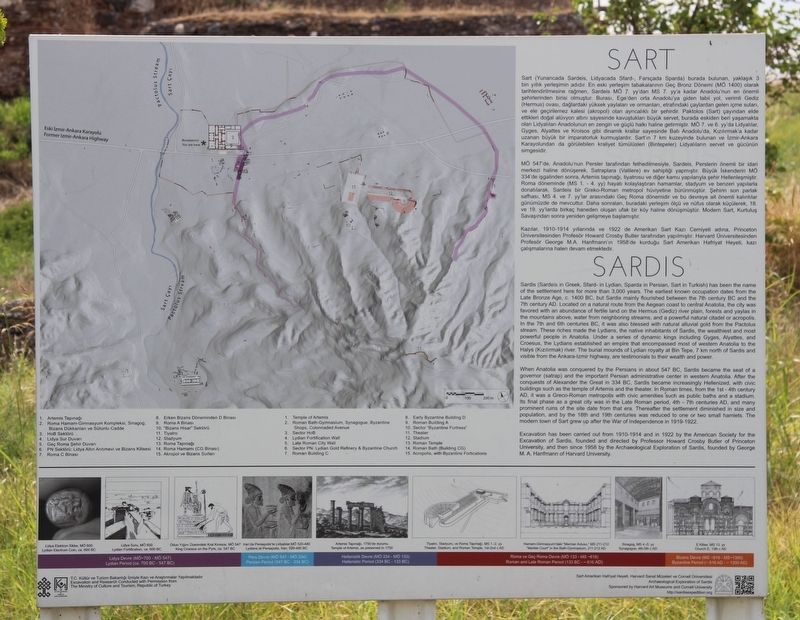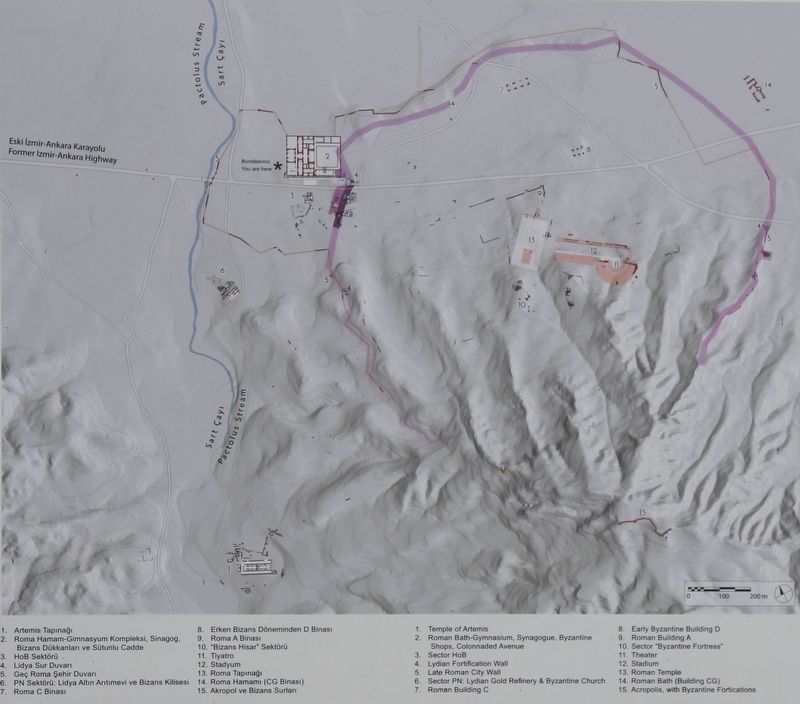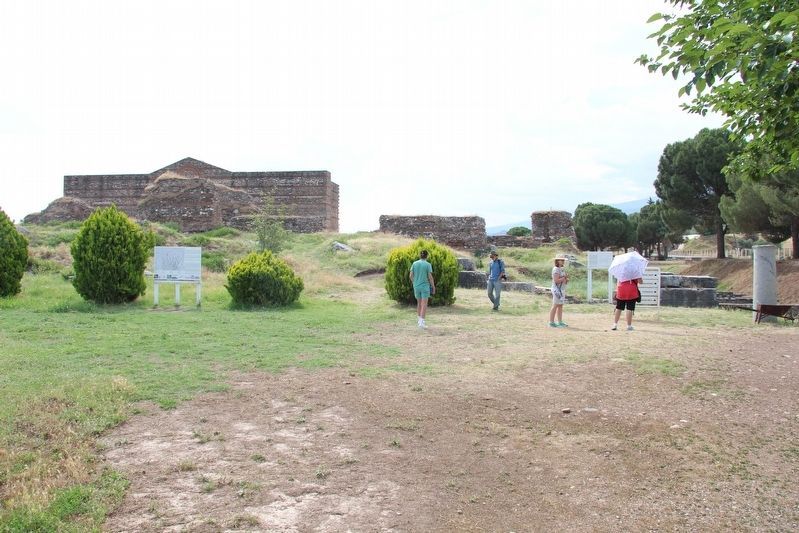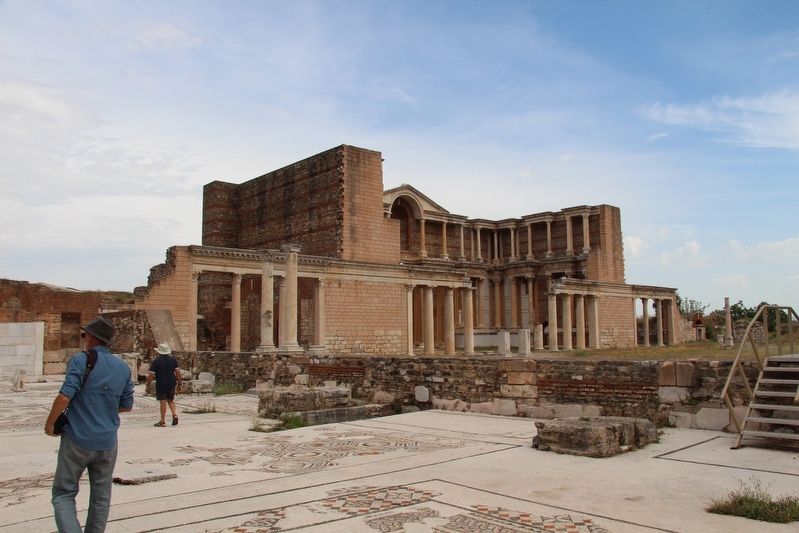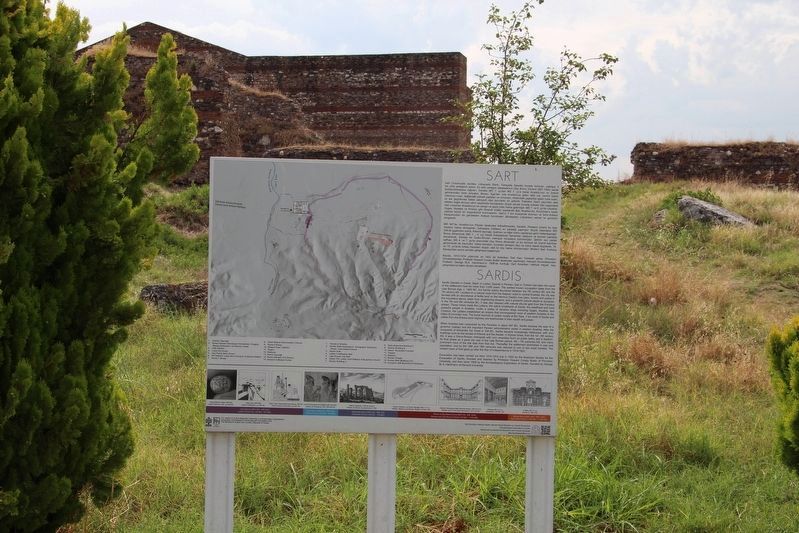Near Sart in Salihli, Manisa, Turkey — West Asia or Southeast Europe
Sardis
English Text:
Sardis (Sardeis in Greek, Sfard- in Lydian, Sparda in Persian, Sart in Turkish) has been the name of the settlement here for more than 3,000 years. The earliest known occupation dates from the Late Bronze Age, c. 1400 BC, but Sardis mainly flourished between the 7th century BC and the 7th century AD. Located on a natural route from the Aegean coast to central Anatolia, the city was favored with an abundance of fertile land on the Hermus (Gediz) river plain, forests and yaylas in the mountains above, water from neighboring streams, and a powerful natural citadel or acropolis. In the 7th and 6th centuries BC, it was also blessed with natural alluvial gold from the Pactolus stream. These riches made the Lydians, the native inhabitants of Sardis, the wealthiest and most powerful people in Anatolia. Under a series of dynamic kings including Gyges, Alyattes, and Croesus, the Lydians established an empire that encompassed most of western Anatolia to the Halys (Kizilirmak) river. The burial mounds of Lydian royalty at Bin Tepe, 7 kilometers north of Sardis and visible from the Ankara-Izmir highway, are testimonials to their wealth and power.
When Anatolia was conquered by the Persians in about 547 BC, Sardis became the seat of a governor (satrap) and the important Persian administrative center in western Anatolia. After the conquests of Alexander the Great in 334 BC, Sardis became increasingly Hellenized, with civic buildings such as the temple of Artemis and the theater. In Roman times, from the 1st - 4th century AD, it was a Greco-Roman metropolis with civic amenities such as public baths and a stadium. Its final phase as a great city was in the Late Roman period, 4th - 7th centuries AD, and many prominent ruins of the site date from that era. Thereafter the settlement diminished in size and population, and by the 18th century and 19th centuries was reduced to one or two small hamlets. The modern town of Sart grew up after the War of Independence in 1919-1922.
Excavation has been carried out from 1910-1914 and in 1922 by the American Society for the Excavation of Sardis, founded and directed by Professor Howard Crosby Butler of Princeton University, and then since 1958 by the Archaeological Exploration of Sardis, founded by George M. A. Hanfmann of Harvard University.
1. Temple of Artemis
2. Roman Bath-Gymnasium, Synagogue, Byzantine Shops, Colonnaded Avenue
3. Sector HoB
4. Lydian Fortification Wall
5. Late Roman City Wall
6. Sector PN: Lydian Gold Refinery & Byzantine Church
7. Roman Building C
8. Early Byzantine Building D
9. Roman Building A
10. Sector "Byzantine Fortress"
11. Theater
12.
Stadium
13. Roman Temple
14. Roman Bath (Building CG)
15. Acropolis, with Byzantine Fortications
Erected by The Ministry of Culture and Tourism, Republic of Turkey, and the Harvard Art Museums and Cornell University.
Topics. This historical marker is listed in this topic list: Notable Places. A significant historical year for this entry is 1400.
Location. 38° 29.33′ N, 28° 2.34′ E. Marker is near Sart, Manisa, in Salihli. Marker can be reached from Kenan Evren Cd. just east of Sart Yolu, on the left when traveling east. This marker is on the grounds of the Sardis Archaeological Park, near the Roman Bath-Gymnasium and Synagogue, in the area where one first enters the park, to begin their tour of the ruins. Touch for map. Marker is in this post office area: Sart, Manisa 45370, Turkey. Touch for directions.
Other nearby markers. At least 8 other markers are within walking distance of this marker. Tuvaletler / Latrines (a few steps from this marker); Boya Dükkán / Paint Shop (within shouting distance of this marker); Lokantalar / Restaurants (within shouting distance of this marker); Roman Avenue (about 90 meters away, measured in a direct line); Mesken / Residence (about 90 meters away); (Yakub'un) Boya Dükkáni / (Jacob's) Paint Shop (about 120 meters away); Bath-Gymnasium Complex (about 120 meters away); Synagogue - Main Hall (about 150 meters away). Touch for a list and map of all markers in Sart.
Regarding Sardis. This marker provides both historical background information as well as a map of the ruins of Sardis. However, it does not mention that this site is also of interest as a pilgrimage site for many Christians since the 1st century church community at Sardis was included as one of the seven churches mentioned in the Book of Revelations.
Credits. This page was last revised on June 26, 2018. It was originally submitted on June 24, 2018, by Dale K. Benington of Toledo, Ohio. This page has been viewed 198 times since then and 10 times this year. Photos: 1, 2, 3, 4, 5. submitted on June 25, 2018, by Dale K. Benington of Toledo, Ohio.
